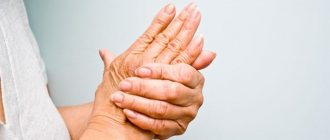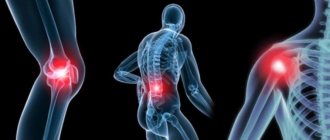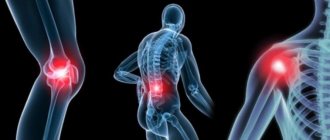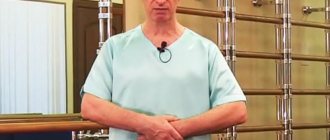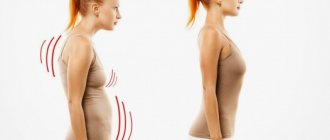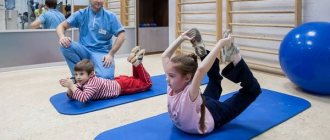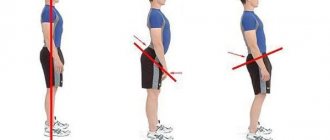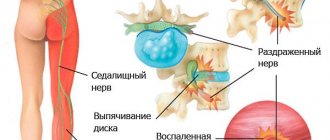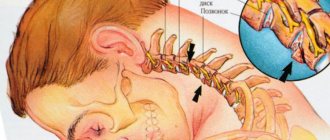Valentin Ivanovich Dikul is a circus performer, the author of a unique treatment method for correcting back diseases, and the director of several rehabilitation centers for the disabled and patients with spinal pathologies. The basis of the Dikul method is not only the regular performance of special exercises in a certain sequence, but also persistent psychocorrection aimed at developing self-confidence and achieving positive results from exercise. Dikul exercises are recommended for many back diseases, but one of the most common indications for therapy using this method is spina bifida.
Dikul: exercises for the back with a hernia
Briefly about the disease
A herniated disc (intervertebral space) is a protrusion that forms when the gel-like disc nucleus is displaced against the background of thinning and damage to the fibrous capsule (fibrous ring). The main cause of intervertebral hernias in almost 80% of patients is dystrophic disease of the intervertebral discs, which develops against the background of an unbalanced diet, bad habits, and a sedentary lifestyle. Factors predisposing to the formation of hernial protrusions of the spine are also obesity of varying degrees, professional activities associated with heavy lifting, chronic stress, endocrinological diseases that negatively affect the rate of metabolic processes.
Visual image of a herniated disc
Clinically, the hernia is manifested by pain (including referred and radiating pain), the cause of which can be either myofascial syndrome or compression of the spinal nerves, which in large numbers extend from the spinal cord in the central spinal canal. The patient also complains of muscle stiffness and tension, limited mobility in the affected segment of the spine, numbness and other paresthesia in the area of the affected nerve. With large protrusions in the lumbosacral region, severe dysfunction of the pelvic organs is possible, manifested by constipation, painful bowel movements, and dysuria. In men, a hernia can cause prostatitis and erectile dysfunction, since the lower parts of the spinal cord are responsible for the functioning of the prostate gland.
Symptoms of a hernia in different parts of the spine
Non-invasive (bloodless) treatment of intervertebral hernias includes the following steps:
- medicinal correction (to relieve pain, relieve muscle spasms, restore blood and lymph circulation);
- therapeutic and health-improving physical education and gymnastics;
- massage;
- physiotherapy (electrophoresis, laser therapy, UHF);
- balneotherapy;
- hirudotherapy (alternative medicine method).
Exercise therapy is the most important element in the complex treatment of back hernias, allowing to improve the functional state of the spine in the area of the affected segment, increase its mobility and prevent possible complications associated with pinched nerve roots and impaired blood flow. Dikul's treatment method is a set of exercises aimed at restoring neurophysiological potential and returning the patient to normal life without the use of surgical treatment methods, which are associated with fairly high risks of disability and postoperative complications.
Exercise therapy is the most important element in the complex treatment of back hernias
Medications
Drug therapy is the most common method of treating both acute and chronic pain in the spine. Some medications not only relieve pain, but also reduce inflammation or help reduce muscle spasms. Typical categories of drugs that may be used in spine treatment include:
- Acetaminophen (analgesic)
- Nonsteroidal anti-inflammatory drugs (NSAIDs) (including aspirin, ibuprofen, naproxen and others)
- COX-2 inhibitors (Celebrex)
- Muscle relaxants (Flexeril, Zanaflex, Skelaxin and others)
- Antidepressants (Elavil, Pamelor, Cymbalta and others)
- Anticonvulsants (Neurontin, Lyrica and others)
- Analgesics (tramadol, Darvocet)
- Opioid analgesics (hydrocodone, oxycodone, OxyContin)
- Physical therapy and exercise
Dikul's technique
Dikul’s treatment program refers to kinesitherapy, the founder of which is considered to be Doctor of Medical Sciences S. M. Bubnovsky. This is a movement treatment method, a type of physical therapy. The program makes it possible to fully restore performance and skills using the neurophysiological potential of your own body. The author of the program developed it from his own experience after, at the age of 15, he received a severe spinal cord injury as a result of multiple local injuries and a compression fracture of the spine. Doctors did not give any favorable prognosis, but, thanks to his own technique, Valentin Dikul was not only able to sit independently and walk, but also completely restored all the functions of the spinal cord and returned to his normal life.
Biography
Today there are several rehabilitation centers in Dikul, a rehabilitation center for patients with the consequences of cerebral palsy, as well as several surgical clinics. The methodology is based not only on developing physical skills and restoring damaged neuromuscular connections, but also working with a person’s psychological potential (almost 42% of patients are diagnosed with various forms of depressive disorders after receiving severe injuries). Dikul is confident that a positive result can only be achieved if a person is completely confident in his abilities and believes that exercise will help him recover, get rid of pain and return to normal life.
Important! Valentin Dikul is confident in the effectiveness of his method of restoring patients with intervertebral hernias, but he immediately states that without the right psychological attitude and firm confidence in a positive result of recovery, one should not expect recovery.
Today there are several rehabilitation centers in Dikul.
Conservative treatment
Medical and alternative treatments
Alternative treatments usually refer to non-traditional medical interventions that do not have a sufficient scientific evidence base. However, alternative medicine is becoming increasingly popular and is often used in spine treatment. The line between traditional and alternative treatments is becoming more blurred every year. A good example is the increased popularity and use of medical acupuncture.
Regardless of the conservative approach, greater success is achieved when patients actively participate in treatment, focusing on restoring function rather than just pain management.
Goals, objectives and features of the method
Exercises using the Dikul method at home can be performed without the use of special devices, but in centers opened under the leadership of the academician, simulators developed personally by Valentin Ivanovich are used to treat patients with intervertebral hernias. Training programs are adapted individually for each patient, so before starting training, you need to discuss the proposed complexes with your doctor and make sure there are no contraindications.
Dikul simulator for therapeutic exercises
The exercises that Dikul proposed help solve several problems at once in the complex treatment of spinal hernias. The therapeutic effect of regular training is manifested by the following changes:
- working out deep-lying paravertebral (paravertebral) muscles and restoring normal muscle tension;
- elimination of muscle spasms and swelling;
- normalization of blood circulation and lymph movement in lymphatic vessels;
- strengthening the muscular corset of the spine;
- elimination of pain associated with hypertonicity of the paravertebral muscles or compression of the spinal nerves.
It is possible to achieve elimination of pain when exercising using the Dikul method in just 4-8 weeks, with a significant improvement in the functional state of the spine and its mobility.
Using the Dikul method you can achieve pain relief in 4-8 weeks
Stages of classes
Classes using the Dikul method are conducted in several stages.
Stages of rehabilitation therapy using the Dikul method
| Stage | Peculiarities |
| First | The main task that classes using the method are aimed at at the initial stage is eliminating pain, relieving muscle tension and increasing the overall tone of the body. Exercises at this stage are performed with minimal amplitude and without the use of additional load. Number of classes – 3 times a week. Duration of the first stage – up to 2-4 months |
| Second | At the second stage of restorative treatment, exercises are used to increase muscle strength and strengthen the muscular corset of the spine. You can add strength training to your classes (using your own weight or weights), and also include asymmetrical movements with maximum amplitude in the training program. The number of trainings increases to 4 times a week, and the duration of this stage can be from six months to 2-3 years (depending on the individual characteristics of the patient) |
| Third | The strengthening stage is based on the creation of a healthy motor stereotype, which involves coordination and strength loads, taking into account the identified pathological focus (the segment in which the hernial protrusion is located). Exercises at this stage help create neurophysiological potential and increase endurance, which will make it easier to cope with household, professional and sports stress without pathological effects on the affected segment of the spine |
Dikul has developed a unique system of exercises that will relieve excess stress from the spine
Important! You can begin the second stage of training only after the pain syndrome has been completely relieved. If a person feels pain while doing exercises, such exercises will do more harm than good, since pain is stress for the body, and the natural reaction to stress is tonic muscle tension (including the muscles of the spine).
Diagnostics
The diagnosis of osteochondrosis of the cervical spine can be made based on data such as:
- Medical history.
First, the doctor needs to study the symptoms and medical history in detail. - Physical examination
. The doctor will then perform a physical examination, palpating the neck and checking the range of motion in the neck. During the tests, patients may be asked to perform certain movements and report whether their neck pain increases or decreases. - If the pain is intense or if there are neurological symptoms such as pain, tingling or weakness in the shoulder, arm or hand, then your doctor will likely order medical imaging.
- Medical imaging methods (radiography, CT, MRI, PET).
If the doctor determines that to determine the exact genesis of the symptoms it is necessary to obtain images of tissues (discs), then an MRI will most likely be prescribed. An MRI, X-ray, or possibly a CT scan can confirm whether there are signs of degeneration, as well as identify other conditions (such as osteoarthritis or stenosis) that may be causing symptoms. - After confirming an accurate diagnosis of osteochondrosis of the cervical spine, as well as any other associated conditions, the genesis of symptoms can be understood and an effective treatment program can be determined.
Class Rules
Valentin Dikul is confident that all patients can achieve positive results in the complex treatment of intervertebral hernias and other spinal diseases using his system, regardless of the severity of injuries, congenital and acquired pathologies. But in order for the classes to be effective, it is necessary to strictly follow the rules that the author developed for stable development of neurophysiological indicators and better adaptation of the body to new loads.
A positive attitude is very important in treatment
- Rule 1. Classes must be regular, without breaks. If the patient has stopped training, it is necessary to start training from the first stage, since muscle tissue very quickly adapts to the intensity of the current load.
- Rule 2. The recommended duration and frequency of classes is 3-4 times a week for 40-50 minutes. At the final stage, the training duration can be up to 1.5 hours, since one of the objectives of the technique is to increase endurance and adapt the body to long-term stress.
- Rule 3. During training, you must monitor the technique of performing the exercises. You can move on to higher amplitudes only after mastering the previous stage of training.
- Rule 4. Only self-confidence and full awareness of why a person needs these trainings and what results he can achieve with strict discipline will help the patient achieve recovery.
It is very important to monitor the technique of performing exercises
Note! Back diseases are a large group of severe pathologies that can extremely negatively affect the functioning of the entire body and internal organs, therefore, before any impact on this area, it is necessary to consult with specialists. If pain or severe discomfort occurs during exercise, you should stop training and consult your doctor to rule out possible complications and exacerbations of existing pathologies.
Exercise therapy
Exercise is considered the mainstay of treatment in conservative spine treatment. If there is pain in the back or leg, a person significantly reduces the range of motion in order to reduce the pain.
However, prolonged bed rest or immobilization causes deterioration, muscle wasting and joint stiffness, leading to a pathological cycle of pain and weakness, so immobilization should be limited.
Back strengthening and stretching exercises should be started as soon as possible. These exercises should not cause pain in your back, neck or limbs. Exercises can be recommended by any doctor, but it is better if the exercise program is selected by a physical therapy doctor and the selection is made taking into account the specific problems of each patient. In addition, changing the distribution of load vectors on the spine through weight loss, correct body mechanics and achieving correct ergonomics at work and at home is of great importance. This comprehensive approach to physical activity allows you to avoid re-injury or worsening pain.
List of exercises
This section contains the most effective Dikul exercises for the treatment of intervertebral hernias, which are recommended to be performed in the order in which they are presented. Before performing the main complex, you need to do a light warm-up for 5-10 minutes, which necessarily includes exercises for stretching the spine and stretching the back muscles. After this, you can move on to the main part of the lesson. All movements are performed smoothly, without jerks or sharp turns.
Warm-up example
Complex for the treatment of cervicogenic (cervical) hernias
The exercises of this complex can be performed from a “standing on the floor” position or sitting on a chair (a chair will not work, as firm support is needed). It is important to ensure that your posture is always straight and your position on the chair is anatomically and physiologically correct. Breathing is smooth and spontaneous.
- Turn your head to the side and stay in this position for a while (the point of maximum tension in the neck muscles). Make a head movement with an amplitude of 180° in the opposite direction. Repeat 5-7 times, gradually increasing the number of repetitions to 10-12.
- Tilt your head back and in this position perform 5 tilts in each direction (try to reach your shoulder with your earlobe).
- Lower your head down, your chin should be as close to your chest as possible. During the exercise, you should feel a stretch in the occipital muscles of the neck. After a few seconds, carefully lift your head up, trying to extend your chin as much as possible, following the top of your head. Repeat 7-8 times.
- Lower your head down and place your clasped hands on top. Try to raise your head up, overcoming the resistance of your hands. Perform very carefully for 15-20 seconds, increasing the execution time to 30-40 seconds.
- Tilt your head to the side and place your palm on top, which is on the same side. Try to raise your head up, overcoming the resistance of your hand (the hand “does not let you in”). Repeat the exercise on the opposite side.
Exercises for cervical hernias
The result will be faster and more pronounced if these exercises are combined with swimming, Pilates, yoga or water exercises (aqua aerobics).
Complex for the thoracic spine
Hernias in the thoracic region are quite rare, but clinically they are also quite painful and can cause severe discomfort to a person. Exercises in this complex will help cope with pain and slow down the progression of pathology (if performed regularly).
- Lie on the floor, spread your legs wide apart. Press your pelvis, feet and buttocks tightly to the floor (they should not move). Place your hands on top of each other (in the form of a cross) and fold them across your chest. In this position, it is necessary to rotate the body to the side, but in such a way that the lower part of the body does not participate in the exercise. You should start with 7 repetitions, increasing their number to 10-12 times.
- This exercise is a continuation of the previous one and is performed similarly, but in this case the hands should clasp the shoulders. The number of repetitions is the same.
- Turn on your side. Stretch the arm that is located below upward parallel to the body (the body should form a straight line). Raise your other hand up and smoothly place it behind your head (both hands should be parallel to the floor and to each other). Fix the position for a few seconds and perform similar actions with the other hand. Repeat 5-7 times with each hand.
Complex for the thoracic spine helps slow down the progression of pathology
Note! For osteochondrosis and hernia of the thoracic spine, various swimming techniques are also useful. It is known that professional swimmers almost do not suffer from these diseases due to the constant and correct load on the pectoral muscles and muscles of the upper back.
Complex for the lumbosacral spine
The lumbar and sacral area is the most common location of intervertebral hernia. Special exercises for the lower back will help correct existing complications and prevent the development of severe consequences, as well as completely get rid of pain and improve the quality of life.
- Lying on a hard surface, pull your heels towards your buttocks and in this position try to spread your knees to the sides as much as possible (“frog pose”). Repeat at least 7-8 times. The exercise must be performed slowly and very smoothly. If knee pain occurs, exercise should be stopped immediately. The “frog pose” exercise is also contraindicated for persons with gonarthrosis (arthrosis of the knee joints) of 2-3 degrees.
- Stay horizontal. Straighten your legs, bring them together and raise them 20-30 cm from the floor. In this position, move them to the side (to the maximum possible amplitude) and return to the starting position. Repeat on the other side. Perform 7-8 times in each direction.
- Sit on a chair. Raise both legs, bent at the knees, up (perpendicular to the floor). Stay in this position, and then perform several turns of the lower part of the body to the sides, without changing the position of the legs.
- Lie on the floor and cross one leg over the other. In this position, raise your legs up 8-10 times, then change legs and repeat the exercise.
The most common location of intervertebral hernia is the lumbar region
Important! All exercises can be performed strictly during the period of remission. In case of exacerbations of chronic back diseases, training should be postponed until acute symptoms are relieved and pain is completely eliminated. It is strictly forbidden to exercise while taking painkillers to relieve pain.
Physiotherapy
Dikul exercises for the spine are suitable for everyone - those who have problems with the spine, and those who do not. It is simple and effective.
- get on your knees and elbows, inhale;
- as you exhale, you need to lean forward, arching your back, with your legs on the floor and your arms straight;
- the starting position is the same. Raise your legs one by one, swinging them;
- from the initial knee-elbow position, swing your hips alternately to the right and then to the left;
- exercise – “The cat is angry.” From the starting position, arch and bend your back alternately;
- position - lying on your back - with your knees bent. Tilt them in this position alternately, then to the right, then to the left;
- lying on your back, pull your legs bent at the knees to your stomach, then both at once;
- lying on your stomach, do push-ups on your hands and on your toes.
Read also…. Treatment of joints with propolis: recipes for tinctures, decoctions, ointments, how to prepare compresses
Possible contraindications
Not everyone can practice the Dikul method. Contraindications for training can be either absolute or relative (temporary), but only the attending physician should make a decision about the possibility of training at a specific stage of treatment and rehabilitation.
Before performing exercises, consult a doctor
The list of contraindications for performing exercises may include:
- infectious and other diseases accompanied by low-grade or febrile fever, or severe intoxication syndrome;
- tumor processes in the spine (including malignant neoplasms, regardless of their location);
- bleeding of various etiologies (women are not recommended to exercise during menstrual flow);
- recent history of injuries and damage to the spine and spinal cord;
- congenital anomalies and developmental defects of the spine.
Important! Women who have even a minimal chance of pregnancy must exclude it before starting exercise (take a blood test for hCG levels or do a test at home).
Video – Dikul’s exercises for hernia
Intervertebral hernia is a serious pathology of the musculoskeletal system, which, if not treated in a timely manner, can lead to serious complications and even disability. One of the methods of conservative treatment of hernias is Dikul exercises, which have proven their effectiveness in tens of thousands of patients. They must be performed regularly, and full recovery may take several years. The author himself considers the correct psychological attitude to be an important key to success, excluding any thoughts of possible failure, so some patients may require professional psychocorrection before starting training.
Imaging methods for spine surgery.
Surgical interventions under X-ray control allow surgical manipulations to be carried out quite accurately, and this, for example, allows the installation of cages or implants with much greater accuracy than under visual control. Typically, a CT scan is performed preoperatively, and intraoperatively, the patient's intraoperative and preoperative images are compared to provide real-time anatomical positioning and guidance for the surgical approach. Preoperative computed tomography (CT) scanning and intraoperative fluoroscopy (real-time x-ray examination) are commonly used as they allow surgeons to perform operations with the highest level of accuracy and safety.
Not all patients are candidates for minimally invasive CT-guided surgical procedures. In some cases, extensive open surgery is necessary.
Intervertebral hernia - clinics in
Choose among the best clinics based on reviews and the best price and make an appointment
Family
Oriental Medicine Clinic "Sagan Dali"
Moscow, prosp.
Mira, 79, building 1 Rizhskaya
+7
- Consultation from 1500
- Diagnostics from 0
- Reflexology from 1000
0 Write your review
Family
Back and joint treatment clinic No. 1
Moscow, Pyatnitskoye sh., 6, bldg.
1 VolokolamskayaMitino
+7
- Consultation from 1000
- Treatment courses from 7000
- Massage from 1500
10 Write your review
Family
Institute of Traditional Oriental Medicine
Moscow, Filippovsky lane, 18
Arbatskaya (FL)
8-(495) 691-66-69
registry
- Consultation from 1200
- Manual therapy from 1300
- Physiotherapy from 700
0 Write your review
Show all Moscow clinics
Intervertebral hernia - specialists in Moscow
Choose among the best specialists based on reviews and the best price and make an appointment with
an Orthopedic Surgeon
Dubinsky Artyom Igorevich
Moscow, st.
Sretenka, 9 (Capital Medical Clinic) +7 0 Write your review
VertebrologistOrthopedistSurgeon
Sychenikov Boris Anatolievich
Moscow, st. Avtozavodskaya, 16, bldg. 2 (Clinic “Medicine 24/7”)
+7
0 Write your review
VertebrologistOrthopedistSurgeon
